Arthropod
The arthropods (Arthropoda, from ancient Greek ἄρθρον árthron, German 'limb, joint' and πούς poús, Gen. ποδός podós, German 'foot') are a phylum of the animal kingdom. They include insects, millipedes, crustaceans (e.g. crabs, barnacles), arachnids (e.g. spiders, scorpions, mites), and the extinct trilobites.
Arthropods are a very successful phylum. About 80 percent of all known recent (non-fossil) animal species are arthropods. They are distributed among nearly a million species of insects, nearly 10,000 other hexapods, about 16,000 millipedes, just over 100,000 arachnids, and nearly 50,000 crustaceans (orders of magnitude only, exact numbers vary by author and year of publication). They probably originated during the Cambrian explosion, when multicellular animal phyla suddenly appeared in the fossil record at the beginning of the Cambrian, about 540 million years ago.
The closest relatives of the arthropods are the tardigrades (Tardigrada) and stump-footed animals (Onychophora), with which they are grouped into the Panarthropoda. Some taxonomists call this superordinate group Arthropoda, the "actual" arthropods are then called "Euarthropoda".
In traditional systematics, this group is grouped with the annelids into the arthropods (Articulata) for morphological reasons. However, recent molecular biological data suggest that arthropods are closely related to nematodes (Nematoda) and their closest relatives (Cycloneuralia). This common grouping is called moulting animals (Ecdysozoa).
Physique
Exoskeleton
The body shell of arthropods forms an outer skeleton that is shed outwards by the epithelial cells of the uppermost cell layer (epidermis); it is called the cuticle. Due to the solid outer shell, growth is only possible by periodically shedding and replacing this shell (molting). The hardened outer covering on the body and extremities is the feature that best characterizes arthropods; similar formations occur only in the related tardigrades.
The body shell consists of chitin and numerous proteins. Chitin and proteins are firmly connected to each other in a web-like manner ("sclerotized") by intercalated compounds derived from dopamine. It can remain flexible thereafter (e.g., on the abdomen of most spiders or numerous insect larvae). Typically, however, hardened, more sclerotized plates (sclerites) are embedded, interrupted by more weakly sclerotized articular membranes, but occasionally may be firmly connected to form sheaths or carapaces. In many crustaceans and millipedes and a few insect (larvae) the shell is further reinforced by calcification.
The integument is colourless, straw-coloured or yellowish, often coloured darkly or brightly by melanin, pigments, occasionally also by structural colours. In insects and spiders, it has a lipid layer as an outer layer to protect against evaporation, which is lacking in millipedes and also in all land-dwelling crustaceans.
Segments
Arthropods have a body divided into segments. The segments have the same basic structure with the same organs, appendages, etc. (with the exception of the first and the last). In all arthropods this basic plan is only partially realized due to numerous variations, but as a rule the segments are clearly distinguishable from each other, and numerous organs (e.g. limbs, openings of the heart, glands, muscles) are segmental.
Traditionally, it is assumed that the arthropods had an indefinite number of similar segments in their basic structure, the number of which was only fixed later in the course of specialization. This assumption, however, is largely based on analogy with annelids. All arthropods, with the exception of some millipedes, the gill-footed crustaceans and the extinct trilobites, have a fixed number of segments; even the lobopods fossilized from the Cambrian, which are generally regarded as representatives of the phylum, had a fixed (and manageably large) number of segments. Within the research community, it is still disputed whether segmentation is an original feature inherited by the arthropods from the common ancestor Bilateria, or whether it is an evolutionary novelty; in this case, segmentation would have evolved convergently in the other animal phyla with a segmented basic plan (especially the annelids and the chordates).
Each segment may have a pair of limbs (legs, mouthparts, antennae), which are also divided into sections, but which may also be absent from different segments. The developmental basis of body segments and leg sections is comparable, and the extremities can be regarded as secondary body axes.
The nervous system is also segmental and consists of a double cord running along the ventral side with a ganglion and a transverse connection (commissure) per segment ("rope ladder nervous system"). Typical is also a dorsal heart and an open blood circulation.
The original structure of a segment consists of the trunk part with a ganglion and a pair of two-branched (biramer) limbs (split legs). The (lower) inner branch is called leg branch or walking leg, the outer branch gill branch, which also indicates the functions.
Merging of several segments (tagmatization)
During the diversification of arthropods in the course of evolution, groups were formed or segments merged. Which segments are fused together to form a tagma is different in different groups. In all arthropods, some of the anterior segments have fused to form the head, which has a brain made up of several ganglia and single- or double-branched limbs formed into mouthparts and antennae. In the different groups of arthropods a different number of segments have fused to form the head.
In primitive arthropods such as the Remipedia, the structure of the body behind the head still largely consists of nearly identical segments. The trilobites had a similarly repetitive body structure.
In the millipedes, ancestors with relatively few segments (12 to 15, depending on the phylum) secondarily gave rise to animals with numerous similar segments; in the millipedes (Diplopoda), two successive segments are fused together to form a double segment, so that each "segment" of the trunk has two pairs of legs; in many centipedes, one broad and one narrow segment follow each other.
In insects, tagmatization is more advanced: several segments each are fused to form the head, midbody and abdomen. The three body segments thus formed have very different functions. The limbs of the original segments of the head have been transformed into antennae and mouthparts. In the midbody (thorax) three segments have fused to form a tagma, whose three pairs of limbs have lost the outer branch and serve as walking legs. Such limbs are called uniramous. In the case of the abdomen, the limbs may be completely regressed or may be remodeled into special organs (gills, mating organs, ovipositor), but they never serve as walking legs for locomotion. In arthropods that do not have visible gills, respiration takes place either through gills (lungs) that are inverted into the body surface or through branched invaginations of the body wall, the tracheae. The abdomen may consist of varying numbers of segments without limbs. The insect wings are traditionally interpreted not as limbs but as remodeled lateral plates of the thoracic segments. However, recent genetic and developmental evidence suggests that they are derived from the gill branch of the original cloven-hoofed leg. (In this case, the gills of aquatic insect larvae, such as mayflies, are homologous formations. Fossil insect larvae exist from the Mesozoic that can be interpreted as transitional limbs).
In the other subtribes, the fusion of the segments has occurred in other variants. Spiders consist of two sections. The anterior abdomen (prosoma) consists of six fused segments. One of the pairs of legs has been remodeled into mouthparts called chelicerae, one into palps, and four into legs. The limbs of the abdomen (opisthosoma) have lost the leg branch, and the gill branch lies as fan lungs in invaginations of the abdomen; in some species these fan lungs have been converted into tracheae. The last pairs of legs have given rise to the spinnerets. In the weaver-carnivores and false scorpions the anterior and posterior bodies are fused into one compact body.
With the horseshoe crabs (Xiphosura), legs are still preserved at the abdomen (leaf-legs), whose gill-branches form fan-gills, that are very similar to the fan-lungs of the spiders.
In crustaceans, the body is usually also divided into head, thorax and abdomen, but the structural plan is varied. In numerous orders of crustaceans one or two original thoracic segments are functionally fused with the head. The thorax has a widely varying number of leg-bearing segments. A limbless abdomen is present or may be absent depending on the related group. In the Malacostraca a limb-bearing pleon is formed instead of the abdomen. At the end of the body there is a tail rudder fused from several appendages. Many other crustaceans have long appendages here (usually called furca). In many crustaceans, the body articulation may be obscured by a body duplicate, the carapace. This can be formed in one piece or in two shells that are movable against each other; in some groups (Ostracoda, Conchostraca) it envelops the entire body, giving it a shell-like appearance. In the Malacostraca the carapace, which was originally only attached to the head, is firmly fused with the thorax, thus forming a uniform cephalothorax which is no longer movable in itself. In some sessile (barnacles, barnacles), but especially in parasitic groups, the body structure may be completely transformed, so that the animal is hardly recognizable as an arthropod.
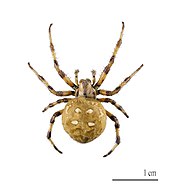
Four-spotted cross spider (Araneus quadratus)
.jpg)
Horseshoe crab
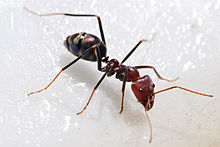
Ant
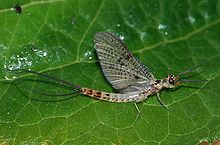
Ephemera
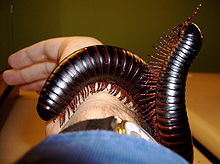
Biped
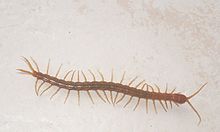
Centipede

A Cuticle and epidermis 1 Epicuticle with details (B): 1a Cementum 1b Wax layer 1c Epicuticula externa 1d Epicuticula interna 2 exocuticula, 3 endocuticula 2 + 3 Procuticle 4 Epithelial layer, 5 Basement membrane 6 Epithelial cell, 6a Pore channels 7 Glandular cell 8 Cuticle pit (bothrion) 9 Heat receptive cells 10 Nerve endings 11 Trichobothrium 12 Sensillum 13 Glandular openings
Sensory
Eyes
Arthropods have a different number (up to nine) of eyes on their heads with very different structures and functions. The eyes of all arthropods have a construction plan that can be traced back to a few basic types, whose partly strongly modified endpoints can be connected by rows. It can therefore be assumed that the eyes of all arthropods represent homologous formations. The eyes can be grouped into two types, each characterized by innervation, receptor and transmitter molecules, these are the lateral eyes and the central eyes.
The outwardly curved side eyes are compound eyes, which consist of numerous individual eyes (compound eyes). The individual eyes are called ommatidia. In insects and crustaceans, the structure of the ommatidia is very uniform: they consist of a retina containing eight light-sensitive sensory cells, above which lies a transparent crystal cone consisting of four so-called semper cells. To the side of this lie two pigment cells, which shield light entering laterally; these also secrete the outer cornea. The cornea is lens-shaped thickened in most groups. In addition to these two so-called main pigment cells, numerous other secondary pigment cells exist. The structure of the ommatidia may be secondarily modified or simplified in other groups of arthropods.
Compound eyes exist in most insects (they are absent in the other Hexapoda) and numerous crustaceans. Among the chelicerates, compound eyes are present in only one group, the horseshoe crabs. The only millipedes that possess compound eyes are the spider runners (Scutigeromorpha). The ommatidia of these groups, however, differ markedly in their fine structure from those of insects and crustaceans. In the horseshoe crab Limulus, for example, each ommatidium consists of more than 300 cells.
In the groups where they are present, the imaging compound eyes are usually the most important eyes. Here the photoreceptors of all the retinal cells of an ommatidium act together to form an image point. The resolution of the compound eye therefore depends on the number of ommatidia, which ranges from a few to a few hundred (e.g. about 700 in the fruit fly or 1000 in the horseshoe crab) to a maximum of 30,000 in some dragonfly species. The spatial resolution of a compound eye never reaches the highly developed lens eyes of vertebrates and cephalopods, but their temporal resolution in motion vision is much better.
In addition to spatial vision, numerous arthropods can distinguish colors from all lines. As in humans, their colour vision is based on the possession of different visual pigments (as in the animal kingdom in general, variants of opsin), which respond at different wavelengths. Also analogous to humans, most have three such pigments (trichromatic vision). In contrast to humans, however, the sensitivity is often shifted to the short-wave part of the spectrum. Many species can therefore not see red, but a portion in the ultraviolet. Another sensory quality that arthropods have ahead of humans is seeing the polarization plane of polarized light. This enables them, for example, to recognize the position of the sun when the sky is overcast, and facilitates the discovery of water surfaces.
Almost all groups that have compound eyes have additional eyes that go back to the middle eyes (exception: middle eyes are missing in all millipedes). In the other arthropods, in which the eyes are not completely regressed, further eye types also occur. Insects usually have three dot eyes (ocelli) on the forehead, the function of which is not clear in all cases; at least in some groups they serve to provide positional information in flight. In crustaceans, three central eyes (four only in phyllopods) form a central visual organ, the nauplius eye, in many groups. This is the most important sensory organ in crustacean larvae, but is also present in numerous adults. In the Malacostraca, one pair of dorsal (dorsal) and one pair of ventral (ventral) central eyes are often developed; in other groups a different number may be present. In true spiders, which never have compound eyes, there is only one pair of median eyes and usually two or three pairs of lateral eyes. In them, however, the lateral eyes never serve for visual vision; in the wolf spiders, jumping spiders, and crab spiders they are motion detectors; in the other groups they serve only for spatial navigation according to the position of the sun, often by detecting polarized light.
In the species-rich group of arthropods, special adaptations exist in numerous groups, each of which enables special sensory performances. Jumping spiders, for example, have enlarged central eyes that enable them to see images according to principles similar to those of the lens eye of vertebrates. Some groups (such as the copepod Labidocera or the larvae of the diving beetle Thermonectes) have evolved eyes with a minimal field of view and high resolution, with which they scan their surroundings with a scanner-like movement. Adaptations to low light conditions are particularly common. Many species that are active at dusk or live at greater depths in the sea have remodeled compound eyes so that light from a larger section of the environment can reach each receptor unit (superposition eye). However, some mainly bottom-dwelling groups have abandoned eyes altogether. This saves them a considerable amount of energy, because in addition to the eyes themselves, a considerable portion of the brain in all arthropods with the ability to see images is used for optical resolution.
In addition to the eyes, numerous arthropods also possess a skin or nerve light sense, which is completely independent of the possession of eyes. This can be used, for example, to detect enemies by casting shadows (e.g. in the crayfish Procambarus clarkii) or to control the gonads by detecting the length of day, as in some butterfly species.
Mechanical senses
Arthropods mainly use two different ways to perceive mechanical stimuli, through sensory hairs or bristles and through receptors that register the deformation of the cuticle (the exoskeleton). These organs serve to perceive the position of body parts in space (proprioceptors), near orientation (sense of touch) and far orientation (sense of vibration, flow, hearing). Although numerous sensors can perform several of these tasks in parallel, some highly specialized organs exist for special purposes.
The sense of touch of arthropods is largely based on simple sensory hairs. In addition, especially the air-living insects and arachnids have developed extremely thin sensory hairs that serve as flow and vibration sensors; these are called filamentous hairs in insects and trichobothria in arachnids. Unlike normal hairs, these are usually embedded in a ring-shaped depression in the cuticle. In all arthropods, sensilla are located directly in the cuticle and can perceive both touch stimuli and vibrations. The receptors (scolopidia) can form special sensory organs, such as the arachnid's cleft sensilla, which in true spiders are clustered in groups (lyre-shaped organ). The chordotonal organs, which are only found in insects and crustaceans, are not visible at all from the outside. Their scolopidia consist of one to four sensory neurons, an enveloping cell (scolopal cell), several attachment cells and enveloping glial cells. Their function has not yet been clarified in detail, but modified cilia are certainly used for the actual reception of stimuli. In insects, so-called dome-shaped (campaniform) sensilla are also present. Important organs for touch, vibration and flow are the antennae; a special organ in the base of the antennae, the Johnston's organ, is used for perception.
Gravity
Spiders and many insects perceive gravity by traction of the body suspended on the legs, in spiders lyre-shaped organs serve this purpose, some insects perceive the pull of gravity on the antennae with Johnston's organs. Crustaceans living in water often show hardly any difference in density compared to the surrounding medium (they can float in water). They have therefore developed their own gravity sensing organs, the statocysts. These consist of a capsule with numerous hair cells pointing inwards. During moulting, some sand grains are inserted into this capsule from the outside, which indicate the direction of gravity by pressing on hairs on one side. The mode of operation corresponds almost completely to the gravitational sense organ of vertebrates. Statocysts are mostly located in the basal antennal limbs, but in some groups also at the end of the body in the uropods or in the telson.
Listen
The perception of sound waves is a special form of the sense of vibration. Numerous arthropods can use the same hair sensors for this, with which they perceive air movements (e.g. by an approaching predator) or vibrations. In some true spiders, sound perception has thus been demonstrated with the trichobothria. In mosquitoes, the males recognize the females by the sound produced by the rapid vibration of their wings (which humans can also hear). For this purpose, their antennae are greatly enlarged; the organ of hearing is Johnston's organ. Acoustic communication by vibration, perceived by the trichobothria, has also been demonstrated in a flagellate scorpion, and may be widespread. In insects, in addition to these sensors, which operate more at close range and are based on direct perception of particle movement, special organs have evolved that also respond to pressure differences, i.e., perceive sound waves like vertebrate ears; these are called tympanic organs. In addition to sensing enemies, sound perception is used by grasshoppers and cicadas (and possibly water bugs), which are also capable of producing sound, to find their sexes. Parasitic flies have exploited this by evolving tympanic organs that can also hear the songs of crickets, which they can thus seek out to lay their eggs on. However, most insects with tympanic organs use them for a single purpose: to hear the ultrasonic locating sounds of bats. This ability has evolved independently in seven families of butterflies, in mantis shrimp, lacewings, and two groups of beetles (sandhill beetles and leafhopper beetles). In each case, the tympanal organs are modified chordotonal organs in which the sensory cells are located on air sacs (dilated tracheae) inside the body. The location is extremely different, in the abdomen (cicadas, most butterflies, short-feathered grasshoppers, sandhill beetles), in the thorax (owl butterflies, mantis shrimp), in the legs (long-feathered grasshoppers), at the wing base (hawkmoths, lacewings), behind the head (flies, leafhopper beetles), at the mouthparts (hawkmoths). While many groups can only hear a narrow frequency band in ultrasound, some have highly developed distance and directional hearing.
It has only been proven in recent years that crustaceans (Decapoda) also possess a sense of hearing. These can perceive low-frequency sound waves of about 100 to 3000 hertz with their statocysts.
Chemical senses
Chemical sensory organs for near orientation (sense of taste) and for far orientation (sense of smell) are present in all arthropods in the form of a variety of sensilla types. In particular, in all groups without highly developed eyes, these are usually the most important organs for foraging. In addition, social communication and sex determination in numerous arthropods is also based on pheromones, which are perceived via chemical sensory organs. The most important sensory organs for chemical orientation are usually the antennae, often also the palps and the outer (distal) limbs of the legs. If antennae and palps are missing, the receptor equipment of the legs can be similarly rich, as for example in the flagellate spiders. Very many arthropods also have chemical sensors scattered over the entire body surface. One to several hundred thousand chemoreceptors are regularly found on an arthropod antenna.
The sensilla, especially of the antennae, are divided according to their morphology into two different groups, the hair sensilla and the pit sensilla, which are connected by transitions (pin- or cone-shaped appendages lying in a pit). Furthermore, according to their morphology, different types of hairs are distinguished, namely dome-shaped (campaniformia), bottle-shaped (ampullacea), cone-shaped (basiconia) and quite a few other types. Although the shape of the receptors is related to their function, it is found that sensory organs of the same shape have different functions in different groups of animals. It is typical for all types of chemoreceptors that their surface is covered by pores (in the micro- to nanometer range). Through these pores, the hollow interior (lumen) of the sensilla is in contact with the outside world. Molecules diffusing in are registered by specialized nerve cells, which are the actual sensory cells. Very often, a single sensory hair can process different sensory impressions, e.g. as a combined chemo- and mechanoreceptor, rarely even three (trimodal). Usually five to ten different types of sensilla are morphologically distinguishable on one antenna.
Sensilla used for food acquisition typically possess a relatively broad, but between different cells quite differentiated sensory spectrum for a variety of soluble or volatile substances such as amino acids, peptides, sugars, nucleotides or amines. The corresponding substance can then be determined from the excitation pattern of different sensors (similar to the sense of taste in humans). In addition, there are highly specialized sensors, especially for messenger substances (pheromones), which only perceive this single substance.
Carbon dioxide sensors
A number of arthropod species, including butterflies, mosquitoes, terrestrial isopods, millipedes and ticks have special sensors that respond specifically to carbon dioxide. These are usually sensilla on the antenna (often bottle-shaped sensilla), but special sensilla on the surface of the head have also evolved for this purpose, e.g. by millipedes. The biological purpose of these sensilla is, for example, host-finding in bloodsucking species or avoidance reactions against suffocation in ground-dwelling species that live in narrow cavities.
Humidity and temperature sensors
Although these are not strictly speaking chemical senses, they are perceived by arthropods from similarly constructed sensilla. Often cone-shaped sensilla serve to cover both properties, often even combined with each other. The specialized infrared radiation detectors of the "fire beetle" Melanophila have become famous. These animals can detect forest fires up to 12 kilometres away, which they fly to specifically in order to lay their eggs in the charred wood.
Magnetic and electrical sense
Perception of the earth's magnetic field is widespread in the animal kingdom and has also been demonstrated in many arthropods. Intracellular iron oxide particles, such as those found in social insects and crustaceans, are used for perception. The magnetic sense probably serves in all cases for large-scale orientation in space.
While it was previously thought that arthropods lacked a sense for electric fields, it has now been possible to demonstrate one in crayfish. However, its sensitivity is an order of magnitude worse than the highly developed electrical sensory organs of many fish species. It is not yet clear what the crayfish use this sense for, but it is possible that it is involved in spatial orientation or in the perception of prey organisms.
.png)
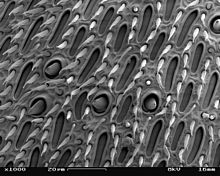
Close-up of the feeler of a wasp with numerous sensory hairs
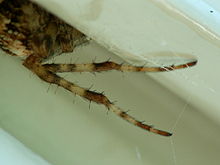
A garden cross spider (Araneus diadematus) has hooked its legs into its web to sense whether insects have been caught via its vibrations
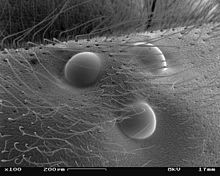
Dot eyes of a German wasp (Vespula germanica)
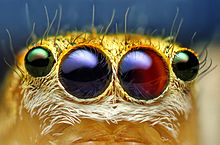
The anterior four lenticular eyes of a jumping spider of the species Maevia inclemens
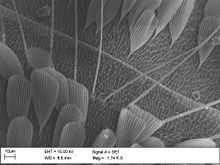
Sensory hairs and other structures on the body surface of a mosquito

Scanning electron micrograph of some ommatidia of a complex eye of a fruit fly of the genus Drosophila
Questions and Answers
Q: What are arthropods?
A: Arthropods are a large group of invertebrate animals that includes insects, spiders, crabs, shrimp, millipedes, and centipedes.
Q: What phylum do arthropods belong to?
A: Arthropods belong to the phylum Arthropoda.
Q: What are some characteristics of arthropods?
A: Arthropods have segmented bodies, an exoskeleton, and legs with joints.
Q: Where do most arthropods live?
A: Most arthropods live on land, but some live in water.
Q: Do arthropods have a lot of species?
A: Yes, arthropods have by far the greatest number of species of any animal group.
Q: Are arthropods a source of food for some animals?
A: Yes, arthropods are a source of food for many animals, including humans.
Q: What is the meaning of the word "arthropod" in Greek?
A: The word "arthropod" in Greek means "joint-legged".
Search within the encyclopedia